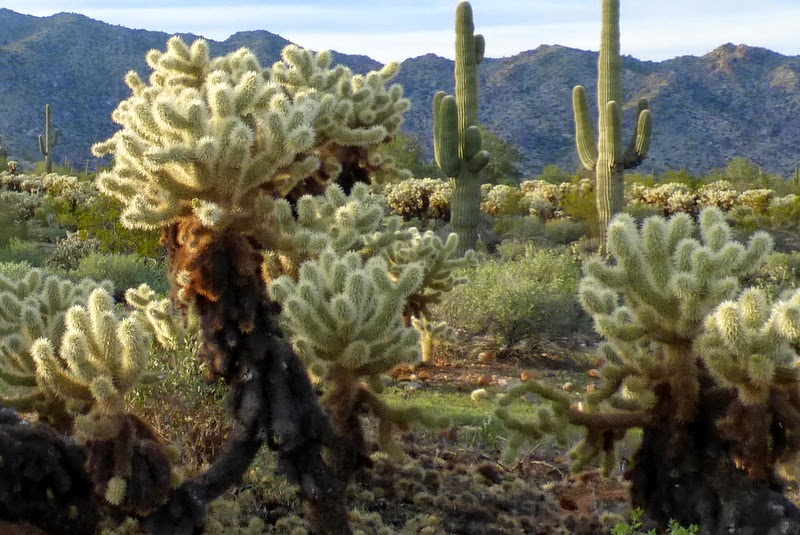We have been exploring White Tank Mountain Regional Park for a couple days. The desert plants are so unique and interesting. I had fun capturing some of the unusual cacti that are here in the desert southwest of the United States, while we hiked some of the trails. The cacti in the foreground and background (low white plants) are called Jumping or Chainfruit Cholla. The reason for the name is that the plant reproduces by dropping segments on the ground where they sprout into new cholla. They look very soft and cuddly, but the white spines are barbed and extremely easily attach to anything that even lightly brushes up against them, thus the name, Jumping Cholla. Once attached, they are very painful and difficult to get off. Pliers are needed to detach them because you certainly do not want to touch them with your hands. There are also two examples of Saguaro cacti in the middle of the cholla forest.
There are many varieties of cholla. Another one that is common in the park is the Buckhorn Cholla. The segments of this cholla are thinner and longer and don't have the number of spines that the Jumping Cholla has. That makes it look more open and scraggly. Here are two examples.
I showed Saguaro cacti with the Jumping Cholla. Saguaro are the ones that have the appearance of people with their arms, however, after awhile they get way too many arms to look like humans any more. The Saguaro are very long living plants. At first, they grow as a straight columnar plant with a ribbed surface and spines along the outer edge of the ribbing. After at least 50 years, arms may start to sprout from the main trunk and flowers begin to appear on the ends of the arms and trunk in the spring. Here is a Saguaro that is just getting its first arms.
Saguaro can grow to 40 - 50 feet tall. The older the Saguaro is, the more arms that it has. These Saguaro are quite old. Eventually, woodpeckers and other birds build nests in the trunks of the plant. The ribs of the Saguaro are vertical, but for some reason, perhaps the direction of the sun shining on them, they appear spiraled around the branches. The enlarged slideshow version should look more normal.
Another type of cactus is the barrel cactus. There are many varieties of barrel cactus. I'm not sure of which one/ones that I have photographed, but they start out as round cacti that have sharp hooked spines. Some grow quite tall, but they look like fat barrels. I guess that I didn't take a picture of the larger barrel.
One variety is called the Many-headed Barrel.
Some of the cacti grow in clumps. They are called Hedgehogs. I was unable to determine, from my Cactus Guide book, which variety I was seeing, but there are two different looking types. One has whitish spines and the other has more golden or brownish spines. These are about 12" tall and stay about that size.
All of the above cacti have blossoms in the spring, usually at the tips of the branches or top of the plant, and grow a fruit that is eaten by animals, birds, and/or humans. It is too early for the flowers to appear although we did see buds beginning to form on some of the cacti. Years ago, we happened to be in the desert in May and the flowers were beautiful! It dismissed all of my preconceived ideas of how barren the desert was.
There are some flowers in the desert now. This is a close up of a Creosote Bush and the whole bush in the second photo. It is kind of spindly, so it is hard to see at any distance. Parts of the plant were used as medicine by the Native Peoples long ago and is still used, although not necessarily recommended, for various ailments by some people today.
Friday was rainy for much of the day. We went to the Nature Center and Library, just outside the gate for the park. In addition to the library, there were displays of live rattle snakes, lizards, spiders and scorpions, as well as a gift shop. We learned that the White Tank Mountains got their name back in the 1860's, when gold was discovered in Arizona. A road was built along the base of the mountain range, near the Gila River, leading to the gold fields. There was a natural depression or basin/tank that held water. It was the largest source of water for 20 - 30 miles, at the time. There were white granite cliffs surrounding the tank, thus the name White Tank Mountains. No one knows where the actual tank was located as heavy rains, over time, have eroded the cliffs, causing them to collapse. They are just going from historical writings. There were no surveys done before the collapse. Outside of the Nature Center, we saw this plant. It was not in my Desert Wildflowers guide book, so I do not know what it was, but it was in full bloom. I have a close up of a smaller bush and a photo of several larger versions that have sort of formed one big bush.
The clouds parted enough to make a very interesting sunset on Friday evening. Here it is at the beginning, most intense and almost gone.
Tomorrow we will be going to the Phoenix International Raceway to attend The Camping World Good Sam Rally.




























